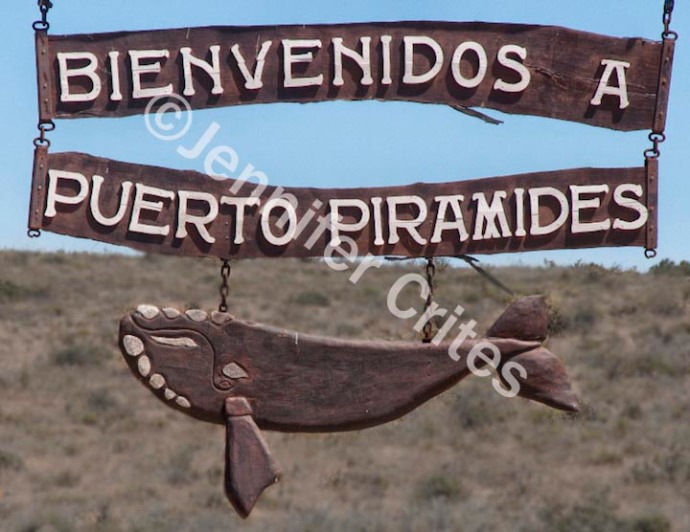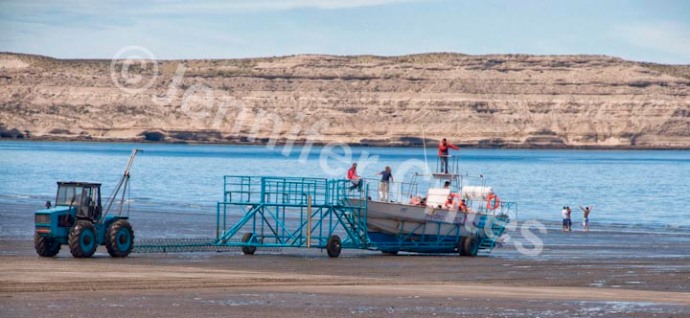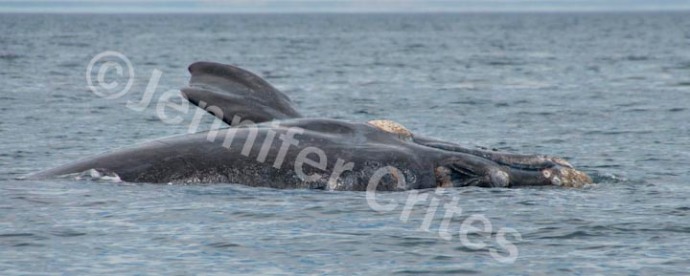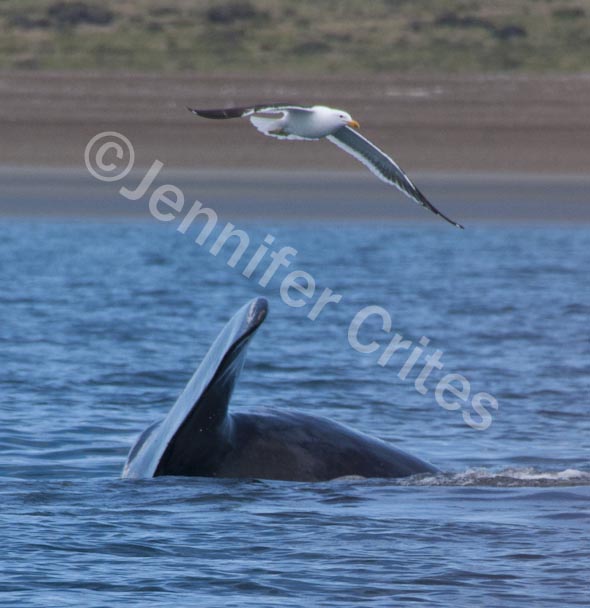 It’s early afternoon in Argentina’s Patagonia, and on Peninsula Valdes, the seaside town of Puerto Piramides is throbbing with tourists lining up to pay for their whale-watching tours. The little hamlet has grown up around these tours, with lodging, restaurants, souvenir shops and a tourist information bureau all catering to the trade and brimming with business.
It’s early afternoon in Argentina’s Patagonia, and on Peninsula Valdes, the seaside town of Puerto Piramides is throbbing with tourists lining up to pay for their whale-watching tours. The little hamlet has grown up around these tours, with lodging, restaurants, souvenir shops and a tourist information bureau all catering to the trade and brimming with business.
Beyond the last restaurant, on an ultra-wide beach fronting a horseshoe bay, there are no boat ramps. Instead, tractors—like monstrous crabs—chug across the sand, pushing and pulling tour boats into and out of the ocean with the aid of long metal arms. Ignoring the vehicles, groups of sunbathers and daytrippers dot the sandy expanse. There’s plenty of room for everyone.
From the ticket office, we march in line to the beach after donning our bulky orange life jackets. Across the sand we go, up the metal steps to the boat’s deck in search of a good seat. During a lengthy orientation in both Spanish and English (mostly Spanish), a tractor pushes us into the sea, and at the proper depth, we float off the trailer and are on our way to see the whales.
It’s speculated that right whales, both Northern (Pacific and Atlantic) and Southern, got their name because whalers declared them the “right” whales to kill. Preferring shallow coastal waters, they swim slowly, passing close to ports and lingering on the surface. All of which made them easy to harpoon. And once killed, they conveniently floated thanks to their thick blubber layer, which was rendered into oil.
Eventually, they became even more prized for their baleen—a tough yet flexible material that forms a giant sieve in each side of the whale’s mouth, allowing it to strain flea-sized copepods (tiny crustaceans) and krill from the water for food. An adult whale must eat a billion copepods a day to supply the minimum 400,000 calories it needs. Polite society, however, decided that baleen was more useful as corset stays, stiffeners in fashionable gowns, umbrella ribs and horsewhips (hence the phrase, “He whaled on me.”)
Even though no longer harpooned for their blubber and baleen, right whales are still fighting for their lives. All are endangered, but the eastern North Pacific population, numbering less than 50 animals, is critically endangered, while the eastern North Atlantic population may be considered functionally extinct, with only ten or so individuals left. Leading causes of death include collisions with ships and entanglement in fishing gear, but in Patagonia there is a lesser-known problem: seagulls.
Kelp gulls might be responsible for hundreds of southern right whale deaths—especially calves—near Peninsula Valdes. They land on the whales, pecking at them to tear off chunks of skin and blubber for food. The hours of harassment and extensive wounds cause stress and weaken the whales at a time when mothers are fasting and expending energy to feed their young. Since this is a recent discovery, no solutions have been found.
Right whales can weigh up to 90 tons, and an adult female can grow to 49 feet long. The male’s testicles weigh around 1,100 pounds each—the largest of any animal and easily surpassing the larger blue-whale’s 120-pound testes.
On this day, no males are available for corroboration, but before long, we spot a mother and calf. They venture close to our small boat, a mass of black skin and white tubercles or callosities that look like clinging barnacles. The callosities appear white thanks to large colonies of cyamids (whale lice).
The whales bob up and down on the water’s surface, checking us out, the mother positioning herself between the boat and her calf. Familiar with barnacle-clad humpbacks that spy hop, I strain to see the right-whale’s eye watching us, but it’s nowhere to be found. I learn that it’s halfway down the massive head, near the corner of the mouth—a curved, plunging line that separates a voluminous lower law from a long, thin upper jaw that reminds me of a safe-deposit box lid with a low hinge, or a trap door leading to a storage cellar.
Perhaps because of the odd mouth and lack of a dorsal fin, it seems like the whale is swimming upside down. I’ve heard that these animals can dive to 600 feet, sometimes flipping over and brushing their flat heads along the seafloor, waiting for the currents to sweep food into their cavernous mouths.
On occasion, I can see the mother’s blowhole. It looks oddly like the thick-lipped mouth on the Dairy Queen commercial, opening wide to suck in air or blow out a water spray, then closing tight before a dive.
Other curious mother-calf pairs check us out, too, but finally we head for shore, passing various sea birds and a colony of seals. The crab tractors are waiting for us when we arrive at the beach.
You can check out Jerry’s video here:



































Great post of the whales! Wow!!
LikeLike
Thanks so much Amy. I’m really glad you enjoyed it 🙂
LikeLike
These are amazing Jennifer. Last night on our news I heard that they now think the Blue Whale comes to a place off our coast to feed at certain times of the year…so exciting. Before it was just thought they were only passing through. They hope to study them here now.
http://www.niwa.co.nz/news/scientists-spot-rare-blue-whales-off-new-zealand-coast-0
LikeLike
That’s awesome, Jo (many thanks for the link). I hope they’ll have blue-whale-watching tours eventually. There’s nothing like being close to these amazing animals in their natural habitat. It helps us feel a stronger connection to them and be more invested in their survival.
LikeLike
Now if only we could convince countries like Japan to stop killing these amazing animals.
LikeLike
Don’t get me started on Japan’s penchant for killing sea creatures. Shark-fin soup as an aphrodisiac—baloney.
LikeLike
Have you watched the movie Blackfish ??? It broke my heart, but I am so glad I watched it.
http://www.seaworldofhurt.com/blackfish.aspx
LikeLike
I just watched the trailer on the link you sent. It breaks my heart just watching that.
LikeLike
The movie is hard to watch at times. But very compelling evidence against what SeaWorld does to these beautiful animals.
LikeLike
The only whales I am familiar with have been the ones I see in Maui. They are amazing and I love to have my morning coffee and watch them play.
I had no idea about these “right” whales. I also didn’t know about the baleen or the predatory bird situation. Is this something knew with the Kelp gulls or had we just not been paying attention?
You educate me every where you go and I appreciate that.
LikeLike
Your kind words and questions reflect, in large part, why I post about my travels—to share, but also to become more aware about the world around me. While composing each post, I research the subject to learn more about it. That’s how I learned about the gulls (and, yes, this is a recent scientific finding). It seems the gull population in Valdes has multiplied, like 1000 percent b/c of fish-processing operations and open garbage dumps.
Your humpbacks in Maui are baleen whales, too—one of the “toothless” whale clan. They don’t eat while in Hawaii (just as the right whales don’t eat at Valdes), but I’ve seen them eating in Alaska. A group of them form bubble nets around their food, pushing the fish all together in a ball then swallowing en masse. Fascinating to watch. And btw, we’re neighbors—I’m on Oahu (the whale viewing is not as good here as on Maui)
Again, thank you for your question and comment, and for being interested in these fascinating creatures.
LikeLike
Jennifer, My apologies, didn’t mean to mislead you. I don’t live in Maui. Unfortunately I have only visited Maui. It is one of my favourite places to spend time. I live in Ontario, Canada.
LikeLike
No problem. We love our visitors, especially those who love us back 🙂
LikeLike
Hi Jennifer,
I can’t get Jerry’s video to work. Hope you both are well!
Sharon
Sent from my iPad
>
LikeLike
Hi Sharon, I just checked with Jerry and he can get the video from his computer at work. The only thing I can think of is that maybe YouTube (it’s on YT, with only a link from here) was having a glitch when you tried, and maybe try it from your home computer. I hope you’ll be able to get it to work. I have more of his great videos that I will put in future posts. He is now officially my video guy 🙂
LikeLike